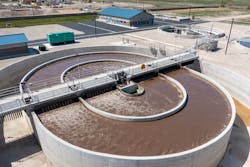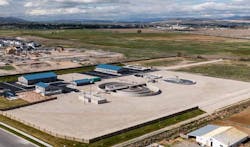Meeting Tight Discharge Limits
David Dubey, P.E., is product manager for Evoqua Water Technologies. Dubey can be reached at [email protected].
undefinedWater is precious to the 8,000 residents of Salem in central Utah, as it is to so many similar places in the arid Intermountain West. Town history attributes Salem’s 19th century founding to its location as a suitable spot for damming up a local spring to create a pond, which is still the centerpiece of the town. Today, with an eye on the future, Salem’s municipal government is still conserving water and educating citizens on efficient water use in their daily lives. At the same time, Salem is planning for the water needs of the future.
Challenge
To meet future wastewater treatment requirements, Salem City would need to meet much much lower limits for ammonia, phosphorus and possibly nitrogen in its wastewater, which discharges into the local watershed. In addition, with an expectation of significant population growth in the next few decades, Salem wants to keep its options open for reusing treated water.
With these requirements in mind, Salem needed a new treatment plant to replace the lagoon system it had been using since the 1980s.
The city’s engineering consultants, Forsgren Associates of Salt Lake City, evaluated several options, including upgrading the existing lagoons, building a regional facility in cooperation with two nearby municipalities, sending wastewater out for external treatment, and building a new wastewater treatment plant of its own. Priorities included maximizing biological nutrient removal (BNR) with a focus on plant reliability, ease of expansion, low odors, and low operating, maintenance costs.
Salem determined a new treatment plant would be the best solution to meet current and future needs while keeping wastewater treatment rates as low as possible. The heart of this system would be a new 1.5 million gallon per day (mgd) Orbal oxidation ditch from Evoqua. The project was approved and commissioned in February 2020.
Solution
The Orbal system, part of Evoqua’s Envirex product family, has been a leader of simultaneous nitrification-denitrification (SND) for BNR for more than 50 years. Easily identified by its tanks-in-series concentric loop design, the system provides high quality BNR performance utilizing the individual dedicated treatment zones.
How the Orbal System Works
The Orbal system’s suspended growth activated sludge process begins when screened and de-gritted wastewater is directed to the outer channel of the basin and mixed with return activated sludge from the clarifiers to form the system’s mixed liquor. The combined mixed liquor passes progressively through the Orbal system’s tanks-in-series design and exits to the final clarifiers. The outer channel is operated as an aerated anoxic reactor with dissolved oxygen levels near 0 mg/L.
Simultaneous nitrification and denitrification and phosphorus release occur in this zone. Oxidation-reduction potential (ORP) is used to monitor the condition of the outer channel. The middle channel is a transition zone between the outer anoxic channel and the inner aerobic channel. Its condition may vary depending on the load coming into the plant. The inner channel is maintained in an aerobic state with dissolved oxygen levels at or above 2.0 mg/L. This supports the final nitrification required to complete treatment. The physically separated, tanks-in-series design creates an environment within each channel that can be controlled precisely to produce consistent treatment results.
Key Benefits of the Orbal System
-
Tanks-in-series design achieves basin redundancy with individual mixing and aeration in each channel.
-
SND treatment in the same zone results in 80% denitrification without the need for an internal recycle pump.
-
Operational flexibility to achieve lower Total Nitrogen or Total Phosphorous as regulations change.
-
Complete mix characteristics and ability to operate at high mixed liquor suspended solids concentrations achieve a high buffer capacity for shock loads.
-
Operating the majority of the treatment volume in a strong oxygen deficit mode allows for much higher oxygen transfer efficiency.
-
The tanks-in-series feature allows high storm flows to bypass the first reactor, preventing clarifier washout of biomass. Proven effective in treating greater than seven times peak flow.
-
Allows for elimination of a dedicated anoxic zone typically used in BNR processes. Reduces footprint, concrete cost, mechanical mixers and operational energy costs.
-
Individual tanks can be shut down for cleaning and still operate the plant, only routine greasing of bearings is required; aerator discs are non-fouling.
Results
Since system startup in February 2020, Salem has been able to achieve and maintain consistent compliance and meet stringent effluent requirements while adding the flexibility to increase capacity to meet future needs. Biochemical oxygen demand, total suspended solids and ammonia are at non-detect or detection limit levels and nitrogen and phosphorus are will within parameters. Operators are pleased that BNR is working well, with no need for chemical addition to meet low effluent phosphorus levels.
The Orbal system’s proven active sludge process supports BNR through a simultaneous nitrification and denitrification design that is reliable, efficient and expandable, to meet the most challenging effluent limits now and into the future.


